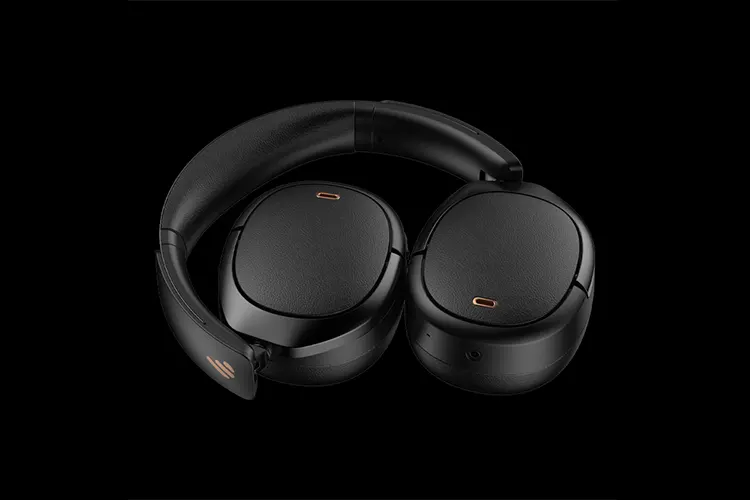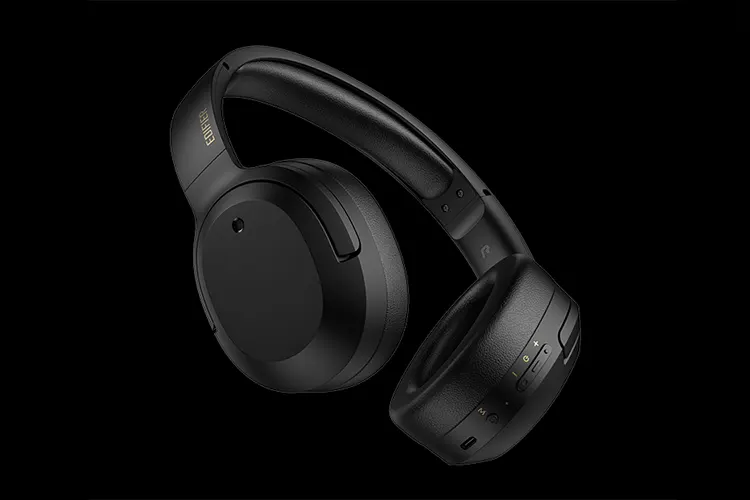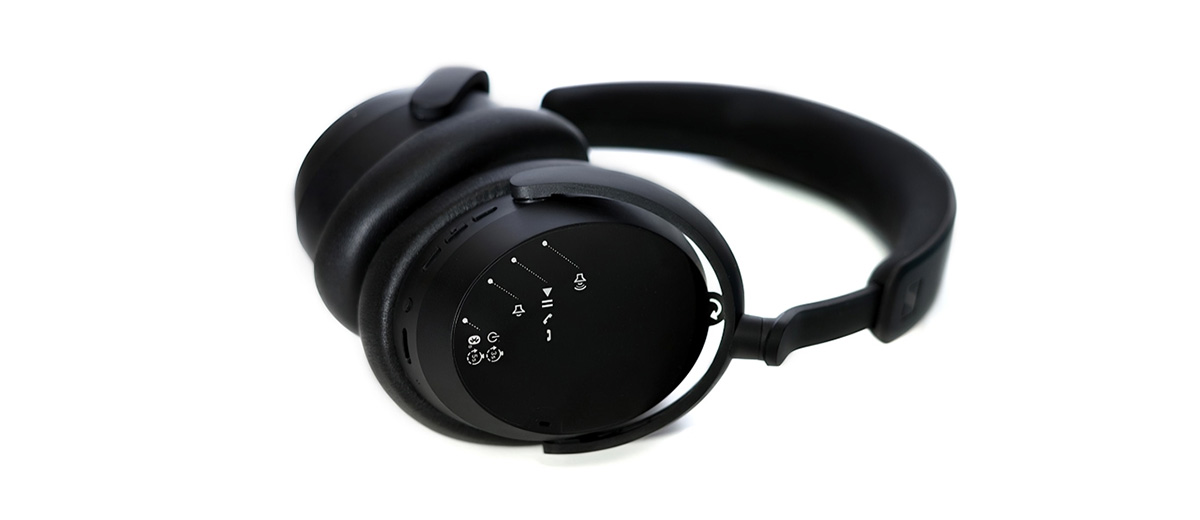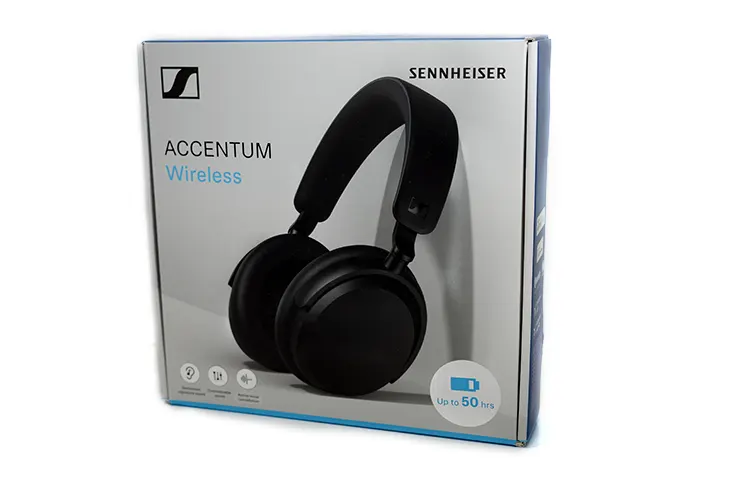Select Comparisons
The following comparisons were made using an iPhone 13 Pro Max and the Cayin N6ii DAP as my main transmitting sources.
Sennheiser Momentum 4 Wireless
Technical
The Accentum uses a 37mm driver, while the Momentum 4 Wireless uses a larger 42mm driver. The Momentum 4 Wireless supports up to AptX Adaptive, and ACCENTUM is up to AptX HD, though all other common codecs are supported by both.
Where the Momentum 4 Wireless uses touch sensitivity on the right ear cup, the Accentum uses tactile buttons for functionality. The Momentum 4 also carries a 3.5mm jack for wired use, while the Accentum is only BT and USB-Wired.
Sennheiser wants everyone to know that the ANC technology is potent and well thought out.
Full immersion (including touch sensitivity of the ear cup) can seen at the forefront of this model, and the Momentum 4 Wireless’s functions around active noise canceling are a match for some of the best ANC headphones currently out.
Sennheiser wants everyone to know that the ANC technology is potent and well thought out.
Full immersion (including touch sensitivity of the ear cup) is at the forefront of this model, and the Momentum 4 Wireless’s functions around active noise canceling are a match for some of the best ANC headphones currently out.
Design
The Momentum 4 Wireless design is extremely well thought out. The selected angles of the headband end up relieving pressure on the top of your head, despite being plastic in the materials used. There is more padding than the Accentum across the underside, which helps comfort.
The plastic design is thick and weighty, lacking any creaks or squeaks when rotating the ear cups in your hand or applying pressure to the headband area. Metal was not used near the ear cups to keep weight down, thus making the headphones more comfortable.
This is a headphone intended for active users, so we do appreciate the quality of plastics used. The headband arc is aluminum and feels slightly pliable with the ability to bend a bit outward before bouncing back into shape.
The ear pads are circumaural but on the smaller side of “full size” (much like the Accentum). Both ear cups rotate and swivel around enough to allow for a very good fit.
On the bottom side of the right ear cup, you will find the power button, which doubles as a pairing mode button when long pressed; light indicators of pairing modes and battery life left; the 2.5mm input for wired cable mode; and a USB-C port.
On both ear cups, you’ll find a mesh metal vent for dual microphones just below the grating.
Performance
The bass in the Momentum 4 Wireless falls slightly behind the Accentum but is better controlled. Taut with very good decay makes for a speedier bass response, enhancing the overall quality over the Accentum as well.
That tighter control makes for a more accurate signature, with a bit less smooth character to the sub-bass.
Conversely, the midrange is more laidback and relaxed. This allows them to become part of the signature instead of becoming shouty or too far forward. There is excellent weight to vocals, making the Momentum 4 Wireless one of the more realistic-sounding ANC headphones, too.
The upper mids add energy, not only making the overall character good in detail but leading nicely to the upper end, which is a statement to Sennheiser’s tuning.
When talking about Sennheiser tuning, words often mentioned include clean, crisp, detailed, and accurate. This is what makes the marque sought after in the high-end market.
On the Momentum 4 Wireless, you can easily hear the familial resemblance in the treble region. Melodic, dynamic, and clean counters the relaxed midrange, allowing the “book-ends” of bass and treble to complete the tuning nicely.
The Momentum 4 is a very good wireless headphone, with excellent ANC, and touch controls on the right ear cup, which get better with each update to the firmware.
Edifier WH950NB
Technical
The Edifier WH950NB uses a slightly larger 40mm dynamic driver compared to the Accentum’s 37mm version.
It uses a slightly newer BT 5.3 chipset with LDAC decoding capability, which is a step up from the Accentum on both accounts.
You can also hook a 3.5mm cable to it, for running a wired setup. Since the Accentum does not have that, I will not cover the wired sound.
With up to 55 hours (34 hours ANC on), the WH950NB is similar to the Accentum. The WH950NB also carries eight ANC modes ranging from on or off, to ambient, theater, gaming, and music mode among others. The ANC tech incorporation is behind Sennheiser’s though.

Design
Built on similar confines as the Accentum, the fit is slightly better, with less clamping force and a bit more padding to the ear cups. The headband also has more cushion to it.
The WH950NB also folds for portable transport, with a slimline case, that fits nicely into a backpack or briefcase.
Nicely accented yokes make for a more upscale look, and the aluminum headband gives a premium look to the unit. That headband does show fingerprints readily, though.
The look and feel of the WH950NB seem to be more upscale than the Accentum due to the construction, even if it is plastic. The gray color is subdued and accented with rose gold inserts and coloration around giving off a semi-luxury look.
Performance
The low-end of both are similar, but the WH950NB will reach lower and with better control. That tight control sounds quite good across many genres, and if it were bass quality only, the WH950NB would win out here.
There is also no bleed into the mids. For sheer bass though, the Accentum comes across with more authority, but less control.
The midrange moves forward more than the Accentum, but with little lift to it, which I prefer. Yes, lifting will enhance the height of the soundstage, but the even nature of the midrange more than makes up for that.
Not as detailed as the Accentum, the WH950NB falls behind here, but there is the smooth character, which evens things out. The Accentum has a very good midrange compared to the WH950NB.
The treble region is essentially a tie, with a slight advantage going to the WH950NB due to its reach and quality. There is even a bit of sparkle to the sound, which the Accentum conveys as richness instead. The Accentum’s upper end is smoother but less defined, helping even out the overall signature.
The cohesion of both is adequate, and this will come down to whether you want more choices in ANC (WH950NB) or more bass quantity and smoothness to the signature (Accentum).
Edifier W820NB
Technical
Sporting a similar 40mm dynamic driver to the WH950NB, the W820NB is an older model with BT5.0 as opposed to BT5.2 or higher, but valid due to similar construction and marketplace.
This would be considered Edifier’s budget wireless headphones but ANC technology is similar to the Accentum with either ANC or ambient sound only.
Design
Made of plastic, with smaller ear cups than even the Accentum, this is almost considered an on-ear headphone as opposed to over-ear.
The ear pads are small and lack a good feel to the padding. Fit also falls behind the Accentum, with the ear pads not sitting flush on my ears.
The headband does have padding similar to the Accentum, but it is not as comfortable. The slider mechanism of the W820NB opens for a more tailored fit to me than the Accentum. Clamp pressure is slightly less than the Accentum.
No case is included, but the pads do fold flat like the Accentum. The Edifier looks budget-minded and feels that way, too. Not overly bad, but a step behind the Accentum.

Performance
You might think with the construction fallacies listed above, that this would not be a fair comparison. But it is due to the sound. What the W820NB lacks in quality construction, it makes up for in sound quality.
The bass is very similar to the Accentum but does not reach quite as low. There is slightly better control to it as well. There is some bass bleed into the midrange, which can hinder the lower mids, but the Accentum has that too. The control in the W820NB outweighs that bleed in my opinion.
The midrange is lifted over the Accentum and has more energy to it. Detail is better in the W820NB, with very good separation. But it becomes a bit shouty when the volume level increases. The fun factor of the midrange wins me over here, even if I cannot turn the volume up too much on some songs.
That energy carries over into the upper range, with a good sparkle to it. The extension goes well beyond the Accentum, but there can be a bit of sibilance to it on songs, which might fall into that category.
Cymbal hits still sound natural and accurate, which helps counter the potential pitfalls here, and that energy translates into a fun signature to me.
Our Verdict
The Sennheiser Accentum is meant to fill a niche in the company’s entry-level wireless headphone lineup. As such, we could reasonably expect it to function well, but not to the level of its more expensive mates.
The Accentum is meant for those people who have not experienced the Sennheiser sound, or only briefly auditioned for a similar model. Or those wanting something different in a Bluetooth headphone. And in that regard, it does the job adequately.
A solid, boisterous bottom end will be loved by those who look for a removal or withdrawal during their morning and evening commute. Or to silence the noises from a flight full of cacophony.
In that regard, the Accentum soldiers on with aplomb. While not the best, you get an introduction to the Sennheiser sound. ANC functions well in these setups.
The fit is an issue for me, and others have mentioned the same concern when I queried them. The clamp pressure was overly tight, and the construction was only adequate, even for this level. But this is overshadowed by that low end, which draws the listener in and smooth character.
The smooth signature belies the typical Sennheiser sound, but the undertones of what we hear are what I would consider nearly typical Sennheiser. If the fit works for you.
Sennheiser Accentum Technical Specifications
- Ear Coupling: Around-the-ear, circum-aural
- Connectivity: Bluetooth 5.2 compliant, class 1, 10 mW (max)
- Transmission frequency/modulation: 2,402 MHz to 2,480 MHz; GFSK, π/4 DQPSK, 8 DPSK
- Supported Profiles: A2DP, AVRCP, HFP, HSP, GATT
- Supported codecs: SBC, AAC, aptX™, aptX HD™, mSBC, CVSD
- Speaker principle: Dynamic
- Speaker type/size: 37mm diameter
- Speaker frequency range: 10 Hz to 22 kHz
- Speaker sensitivity: 106 dB SPL (1 kHz / 0 dBFS)
- Speaker THD: <0,3% (1 kHz / 100 dB SPL)
- Active Noise Cancellation: Hybrid ANC
- Mic principle: MEMS
- Mic frequency range: 50 Hz to 8 kHz
- Mic pick-up pattern: 2 mics, beamforming for noise reduction
- Battery lifespan: Up to 50 hrs. music playtime via Bluetooth and with ANC (test condition: iPhone, medium volume level)
- Charging time: Approx. 3 hrs. for full charge; After 10 min charging up to 5 hrs. music playtime
- Battery type: Built-in Lithium-Ion rechargeable battery 800 mAh
- Power Supply: 5 V⎓, 700 mA max, USB charging via USB-C socket
- Magnetic field strength: 3.0 mT
- Product weight: 0,222 kg



